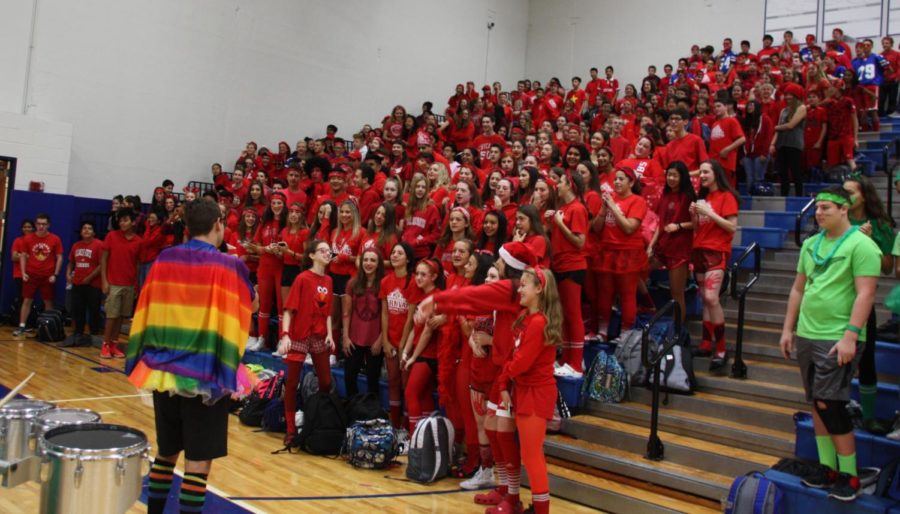VHHS administration to get creative in accommodating increasing enrollment
The freshman class is the only grade to fill their entire section of the bleachers during Color Wars.
This year, Vernon Hills High School students and teachers welcomed the largest Freshman class in the school’s history. With an enrollment of approximately 380 students, the class size is definitely a change from the typical 300-student class sizes seen in grades 10-12. This is noticeable in assemblies when the class fills up the bleachers fully, where no other class does.
“The freshman class size is pretty noticeable this year,” said Ceci Gao (11). “At assemblies, you just feel their presence.”
These trends are predicted to continue, according to administration. Dr. Guillaume and Dr. Young anticipate that the incoming freshman class will be about 400 students; this class size is projected to continue for the future.
“Here’s the thing with expectations. We are never quite sure,” Guillaume said. “What we do know is that the Hawthorn classes are getting larger… it is indicative of a trend.”
While expectations of larger class sizes could be wrong, administration is prepping for this to become a reality. Young is currently completing a facility utilization discovery, which is an analysis of class sizes that shows trends in how close classes are to capacity. This will help the school understand where they are beginning to run out of space and how to better utilize the space they do have for future classes.
According to Young, the Science Department is currently most restricted in where it can be moved to, but the most tightly used department is actually World Languages. Still, administration is not panicking; they just need to get creative with where all classes are located.
Young stated that administration is currently asking the questions, “What rooms have we always been used by a certain class?” and “Do they need to be used for this [class’s room] moving forward?”
Ideally, teachers would not have to move throughout the day from room to room to teach different classes, Young explained, but administration is “getting creative” for future classes. Teachers may need to start teaching classes in spaces that were once designated for a different class or department in order to accommodate for increasing enrollment. Still, they do not plan to build an addition or move to classes to trailers like the elementary school.
Science Department Supervisor Mr. Prosise explained, mirroring Young, that if enrollment continues to increase at a rapid rate, the Science Department will need to reconfigure their layout; a room that was once designated for just Chemistry may need to be used for Chemistry and Biology in the future.
“As of right now, we have plenty of room in the current science classes to hold a substantial increase in students,” Prosise explained. “I suppose if enrollment truly began to grow [beyond what is projected for the next few years], we would need to get creative and put classes where they have never been held before.“
Both Young and Guillaume agreed that in the future, classes will begin to hit or slightly exceed their recommended number of students — optimums — for each class. A class that has an optimum of 28 may have previously held 26 students, but in the future, that class may be required to hit that 28 student optimum, or exceed it at 29 students.
These optimums may be exceeded as these are only “soft caps” to class sizes, according to Mr. Caton, AP Human Geography teacher. Mrs. Etnyre, vice president of the teachers’ union, explained that the use of the word optimum, rather than the word maximum, supports Caton’s view of optimums as a “soft caps” as they are not absolute limits to class sizes.
Administration agrees that this increasing enrollment will not be the end of the world for Vernon Hills High School. There may be more students and some crowding, but this most likely will not harm anyone.
“I don’t think it hurts our community except it makes the halls feel a bit more crowded,” Guillaume explained.
Center for Public Education’s studies have proven that smaller class sizes are extremely beneficial at a young age (kindergarten to third grade), but results vary in other age groups. So, according to this government source, there is no conclusive data as to whether larger class sizes are harmful to high school students.
Caton shared that it in the future, increasing class sizes may make grading and one-on-one help more difficult, but he has not experienced negative impacts of increasing class sizes thus far. As is, Vernon Hills High School has smaller class sizes than other schools, according to Caton, who used to teach classes of 35 at his old school.
So, in years to come, students and teachers may expect some crowding. There may be a greater wait to take the stairs during passing periods or less personal space in the bleachers, but it is not expected to harm student life.
As Dr. Guillaume put it, “Ultimately, the benefit is that we get to impact a bigger number of kids… so for more kids to have the opportunities that our current students have right now is a great thing for the community.”

